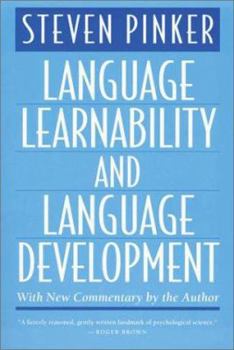Language Learnability
Select Format
Select Condition 
Book Overview
In this study, Steven Pinker develops an approach to the problem of language learning. This edition is reprinted with a new commentary by the author.
Format:Paperback
Language:English
ISBN:0674510534
ISBN13:9780674510531
Release Date:February 1996
Publisher:Harvard University Press
Length:474 Pages
Weight:1.55 lbs.
Dimensions:1.3" x 6.1" x 9.1"
Customer Reviews
1 rating
Language and Grammar
Published by Thriftbooks.com User , 22 years ago
Almost without exception, children are able to learn how to speak the language of the adults around them. They do this using only the example those adults supply by speaking. While adults do simplify their speech when talking to very young children, we rarely have a formal program of language instruction in mind. Rather, we simplify our speech so that we can be understood. From this input children are able to learn to distinguish words, understand the meaning of words and combine them into sentences. In no time a child is speaking his language and speaking it correctly. How this process occurs is the topic of Steven Pinker's monograph "Language Learnability and Language Development". He focuses on how a child can learn the grammar of his language. His approach is quite formal and technical, as is fitting for a professor of linguistics writing for an audience of professional researchers. The ultimate goal is to define a set of algorithms that processes the input (the sentences heard by the child) and creates a set of rules that define the grammar of the language the child is hearing. Pinker's description of this process begins with the question of word order. A child must determine in what order his language puts words. Should he put the subject before the verb (He runs. vs. Runs he.), should an adjective precede a noun (white house in English, casa blanca in Spanish)? Where should an indirect object go? This isn't easy work. All the child has to go on are the sentences she hears and some non-verbal signals (pointing, tone of voice, the context of the utterance). Actually, the child has a little bit more; Pinker argues, as do many linguists, that we are all born with a mental framework for grammar. This can be imagined as a series of rules with some blanks to be filled in. All of the world's grammars can be described by filling in the blanks differently. So the child is not without some guidance. Once the child has identified the basic meanings of some of the words this framework for grammar and the algorithms Pinker proposes work together to determine how sentences are constructed. As the child learns more words and more of the basic grammar rules, more difficult notions can be tackled. The text proceeds through topics such as noun-verb agreement, verb forms and irregular verbs, auxiliary verbs (including the troublesome word "do" in English) and the formation of passive constructions. For each issue Pinker describes a framework and a series of rules for filling the blanks. The fundamental constructs and the nature of the rules require the reader to have some understanding of formal grammars (the transformational grammars of Chomsky or the LFG that Pinker bases his arguments on). Your understanding doesn't have to be deep, but it would be difficult to work your way through the book without some familiarity with the subject. Further the algorithms are given reasonably formally (not purely mathematically, but certainly it requires some effort to pi





